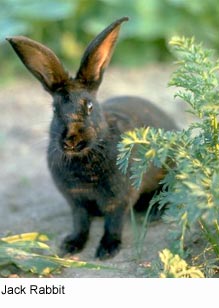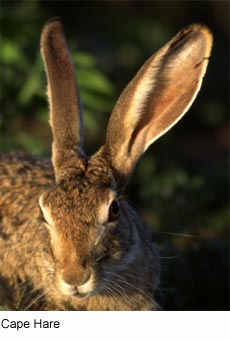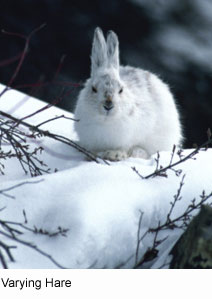|

 Just the Facts: The European Hare or Brown Hare (Lepus europaeus) is a species of hare native to northern,central, and western Europe and western Asia. It is larger, longer-eared, and longer-legged than a rabbit. It has a body size of 50-70 cm and a tail length of 7-11 cm. The weight for a full-grown adult ranges from 2.5 to 6.5 kg. It can run at speeds of up to 70 km/h (45 mi/h). Just the Facts: The European Hare or Brown Hare (Lepus europaeus) is a species of hare native to northern,central, and western Europe and western Asia. It is larger, longer-eared, and longer-legged than a rabbit. It has a body size of 50-70 cm and a tail length of 7-11 cm. The weight for a full-grown adult ranges from 2.5 to 6.5 kg. It can run at speeds of up to 70 km/h (45 mi/h).
It is strictly herbivorous. It eats grasses and herbs during the summer months but changes to feeding on twigs, bark, and the buds of young trees in winter, making it a pest to orchard farmers.
Big Ears: The Black-tailed Jackrabbit has unmistakable long ears, and the long powerful rear legs characteristic of hares.
Salt and Pepper Hare: Its fur is dark buff peppered with black. Its ears are tipped with black, and it has a black stripe down its back. The tail is black above but white beneath. It is the largest North American hare, reaching a length of about 60 cm, and adults weigh between 1.5 and 4 kg.

 Proud Parents: Hares do not bear their young below ground in a burrow as do other Leporidae, but rather in a shallow depression or flattened nest of grass called a form. Proud Parents: Hares do not bear their young below ground in a burrow as do other Leporidae, but rather in a shallow depression or flattened nest of grass called a form.
Young hares are adapted to the lack of physical protection offered by a burrow by being born fully furred and with eyes open. They are hence able to fend for themselves very quickly after birth, that is to say they are precocial. By contrast, the related rabbits and cottontail rabbits are altricial, having young that are born blind and hairless.
The hare's diet is very similar to that of the rabbit.
Spring Frenzy: The European
Brown Hare (Lepus europaeus) can run at speeds of up to 70 km/h (45 mi/h). Normally shy animals, hares change their behavior in spring, when they can be seen in broad daylight chasing one another around meadows; this appears to be competition between males to attain dominance (and hence more access to breeding females). During this spring frenzy, hares can be seen "boxing". This is where hares strike one another with their paws.
Complicated Love Affair: For a long time it had been thought that this was more inter-male competition, but closer observation has revealed that it is usually a female hitting a male, either to show that she is not yet quite ready to mate or as a test of his determination.
 Big-foot: The Snowshoe Hare (Lepus americanus), also called the Varying hare, is a species of hare found in North America. It has the name "snowshoe" because its back feet are so big, it looks as though it is wearing big shoes to walk in the snow. The animal's big feet prevent it from sinking into the snow when it hops and walks. Big-foot: The Snowshoe Hare (Lepus americanus), also called the Varying hare, is a species of hare found in North America. It has the name "snowshoe" because its back feet are so big, it looks as though it is wearing big shoes to walk in the snow. The animal's big feet prevent it from sinking into the snow when it hops and walks.
For camouflage, its fur turns white during the winter and rusty brown during the summer. Its underparts are white year-round. The Snowshoe hare is also distinguishable by the black tufts of fur on the edge of its ears. Their ears are shorter than those of most other hares. In summer, they feed on plants like grass, ferns and leaves; in winter, they eat twigs, the bark from trees and buds from flowers and plants. They are sometimes seen feeding in small groups.
Just the Facts II: These animals are mainly active at night and do not hibernate. Snowshoe hares may have up to 4 litters in a year which average 2 to 4 young. Males compete for females and females may breed with several males.
All text is available under the terms
of the GNU Free Documentation License
|